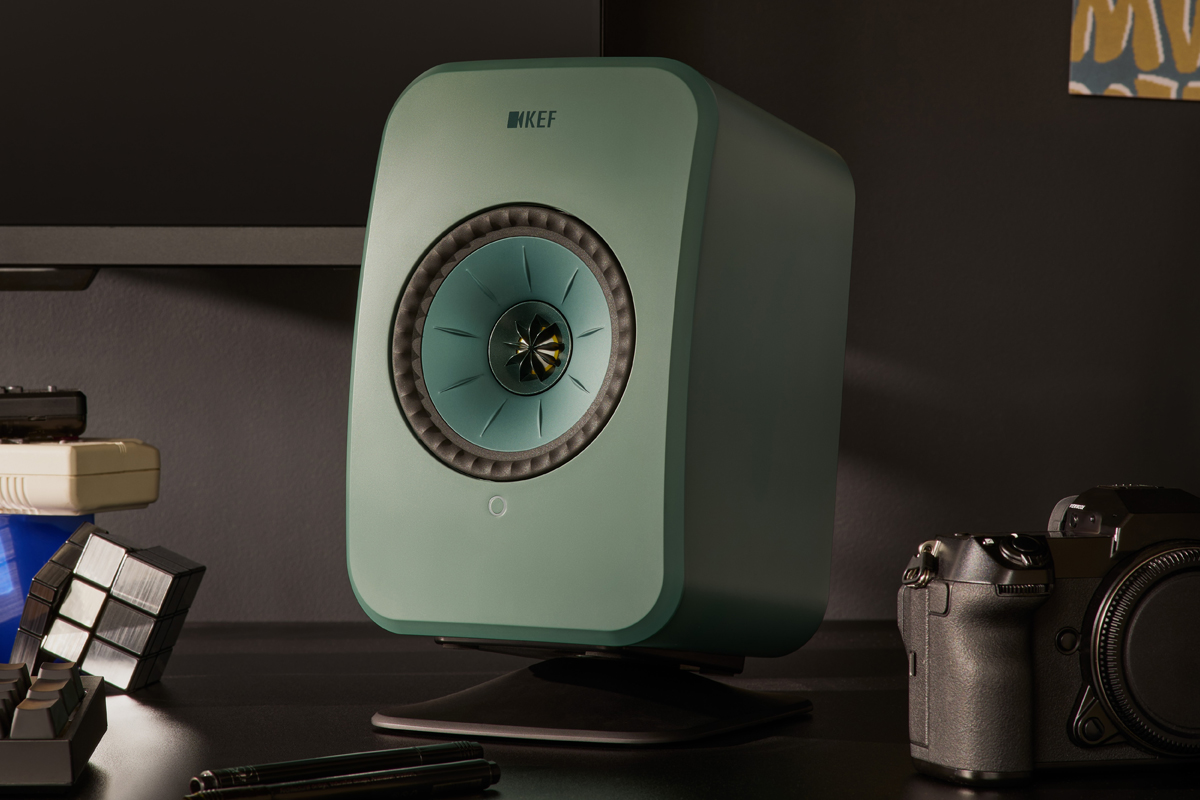In a sense, what you’re reading here is a review of two different products—the LSX II LT active speaker system that KEF announced on January 18 of this year, and the LSX II system on which it’s based.
Both models employ the same Uni-Q driver array, which combines a 4.5″ magnesium-aluminum midrange-woofer and concentrically mounted 0.75″ aluminum-dome tweeter. On both models, the midrange-woofer is powered by a class-D amp specified to output 70W, and the tweeter by a class-D amp rated at 30W. The rear-ported enclosures on both models have identical dimensions. So it’s safe to conclude that their sonic characteristics are very similar; probably identical.
Their feature sets aren’t identical, but they’re close. Both models have ethernet, Wi-Fi, and Bluetooth connectivity. Both employ KEF’s W2 wireless streaming platform, which supports Apple AirPlay 2, Chromecast, Spotify Connect, Tidal Connect, and UPnP/DLNA. Both work with the companion KEF Connect app, which allows lossless and hi-rez streaming from Amazon Music, Deezer, and Qobuz. The app also has internet radio and podcast functions. The LSX II can perform MQA decoding and rendering. The LT version does not support MQA, but with Tidal now using FLAC for hi-rez streaming, is that even an issue anymore?
But the LT version reviewed here is $300 cheaper—$999.99/system as opposed to $1299.99 (all prices USD). What accounts for the lower price?
Cost cutting
Some of the differences are immediately obvious. The LSX II LT is available in three satin finishes: Graphite Grey, Stone White, and Sage Green. The LSX II has fancier finishes: high-gloss Mineral White and Lava Red; Olive Green, Cobalt Blue, and Carbon Black fabric; and a funky patterned beige fabric that KEF calls “Soundwave.” Both models have USB-C, optical S/PDIF (TosLink), and HDMI-ARC inputs. But the LSX II also has a 3.5mm stereo analog input.
The main difference between the LSX II and LSX II LT is the overall architecture. Both models are sold as pairs comprising a primary and a secondary speaker. In addition to the Uni-Q driver arrays, the primary and secondary speakers on both models each house the amplifiers that power the two drivers, as well as digital signal processors that perform crossover and other functions.
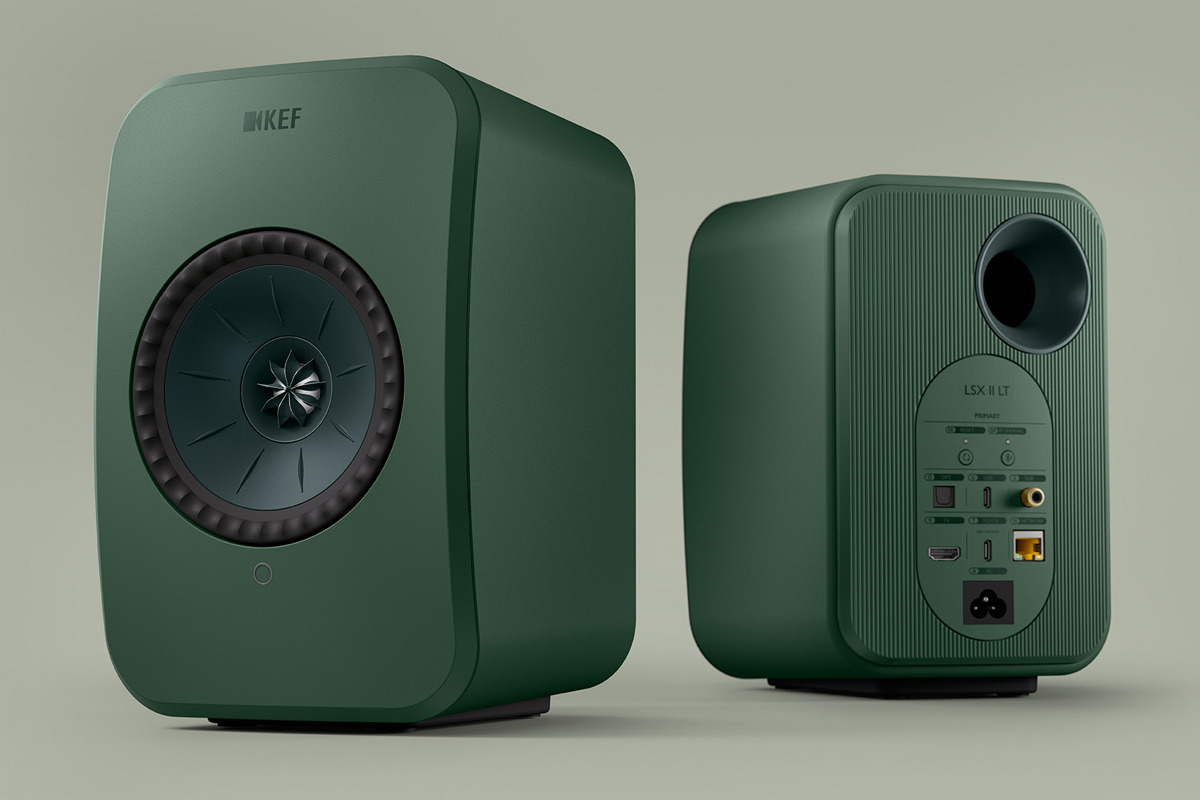
With the LSX II, you can use a wired or wireless connection to send audio from the primary to the secondary speaker—24-bit/96kHz PCM with a wired connection, 24/48 if you go wireless. With the LSX II LT, you have to use the supplied 5m (16.4′) USB-C inter-speaker cable—there’s no wireless option. In addition to carrying 24/96 PCM audio, that cable carries 5V DC to power the electronic circuitry inside the secondary speaker. If you need a longer inter-speaker cable (say if you want to route it around room structures like doors), KEF offers an 8m (26.25′) cable for $59.99.
With this architecture, a single power supply housed in the primary speaker is used for the electronics in both speakers in the LSX II LT system, Jack Sharkey, senior technical engineer for KEF, told me in a video call. The LSX II system has two power supplies, one in each speaker. The reduced bill of materials is the main contributor to the lower cost of the LT version, Sharkey explained.
Outside and in
The LSX II LT’s front baffles curve gracefully outward, both horizontally and vertically, eliminating the possibility of cabinet diffraction effects. Mounted right in the center of each speaker is the Uni-Q driver. The tweeter in the center has a finned waveguide in front of the dome to optimize directivity and frequency response. Below the driver on the primary speaker is an LED that glows different colors to indicate selected input and network status.
KEF provided a review system with the Stone White finish. The cool-white enclosure contrasted attractively with the pleated black surround and silver cone of the midrange-woofer, the silver tweeter waveguide, and the light-gray KEF logo above the driver. On the Sage Green and Graphite Grey versions, the logos, surrounds, cones, and waveguides are black. These are stylish-looking speakers.
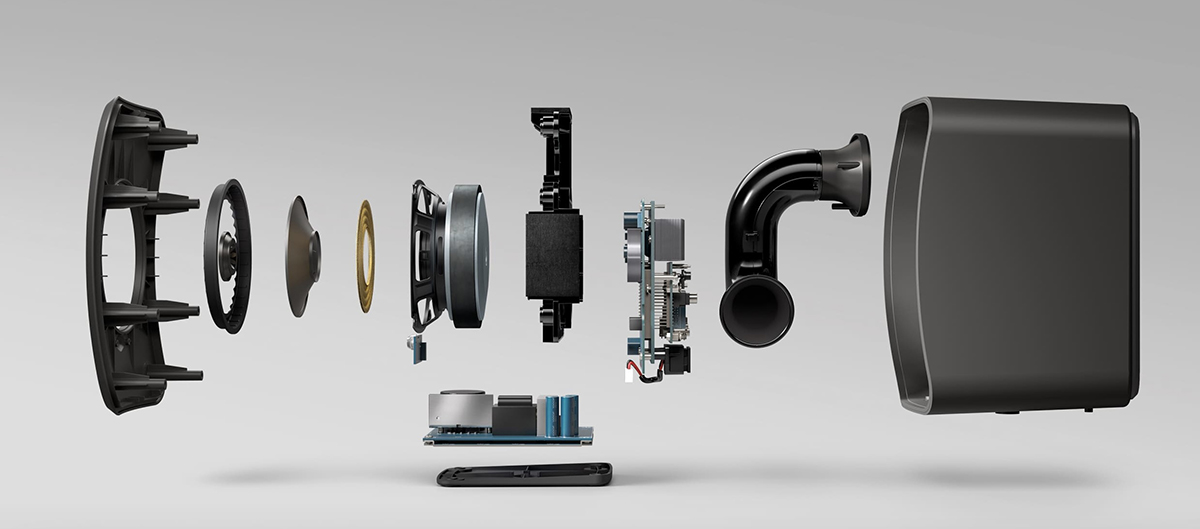
Each enclosure measures 9.5″H × 6.1″W × 7.1″D. On both speakers, the flared bass port is located at the upper-right corner of the rear panel. The only other element on the rear of the secondary speaker is the USB-C input for the inter-speaker cable. On the primary speaker there is also a connection panel with reset and Bluetooth-pairing buttons on the top row; optical S/PDIF input, USB-C input, and subwoofer output on the second row; HDMI-ARC port, USB-C inter-speaker output, and ethernet port on the third row; and at the bottom, a three-prong inlet for the power cord.
The system can accept PCM audio up to 24/384 over a network connection, 24/96 via USB or TosLink, and 16/48 via HDMI. If you connect a subwoofer, you can adjust crossover frequency and subwoofer level in the KEF Connect app. The DSP will implement a low-pass filter for the sub and a high-pass filter for the speakers, freeing the 4.5″ drivers from having to reproduce deep bass. There are presets in the app for KEF subwoofers.
Like all of KEF’s wireless speakers, the LSX II LT comes with a simple plastic remote control that lets you adjust volume, cycle through sources, skip tracks, pause and resume playback, mute and unmute playback, and power the system on and off.
Unlike KEF’s other active speakers, the LSX II LT is not Roon Ready, even though it uses the same W2 streaming platform as those models. But Sharkey confirmed that KEF has submitted the new model for Roon certification. This can take several months; in the meantime, users can stream to the LSX II LT from Roon via AirPlay or Chromecast.
Software and setup
The LSX II LT comes with a cryptic Quick Start Guide, but a downloadable manual is available on KEF’s support site. After you connect the primary speaker to a power outlet and connect the inter-speaker cable to both speakers, the next step is to download the KEF Connect app to your mobile device, and then set up a user account with KEF. (Why do companies make you do this?)
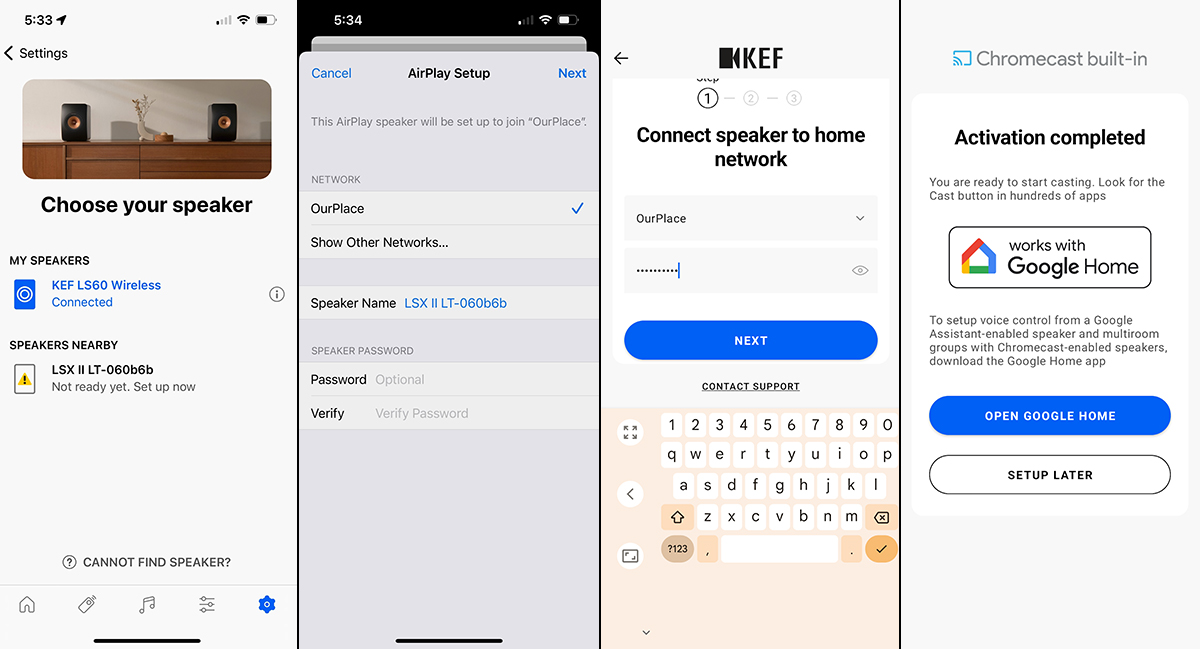
The setup sequence is different for iPhone and Android users. With both versions, if you don’t already have a KEF wireless speaker system on your home network, you’ll see the LSX II LT listed under the heading “Speakers Nearby,” accompanied by a message reading, “Not ready yet. Set up now.”
When I chose that option on my iPhone, I was bounced to the Apple AirPlay Accessory Setup screen where I confirmed the name of my network, after which iOS completed the setup. On my Google Pixel phone, the app directed me to a screen where I confirmed my network name and entered my network password; it then connected the speakers to my home network. The setup process went smoothly on both phones. After that, the app confirmed that the system’s firmware was up to date and enabled Google Chromecast. Easy-peasy.
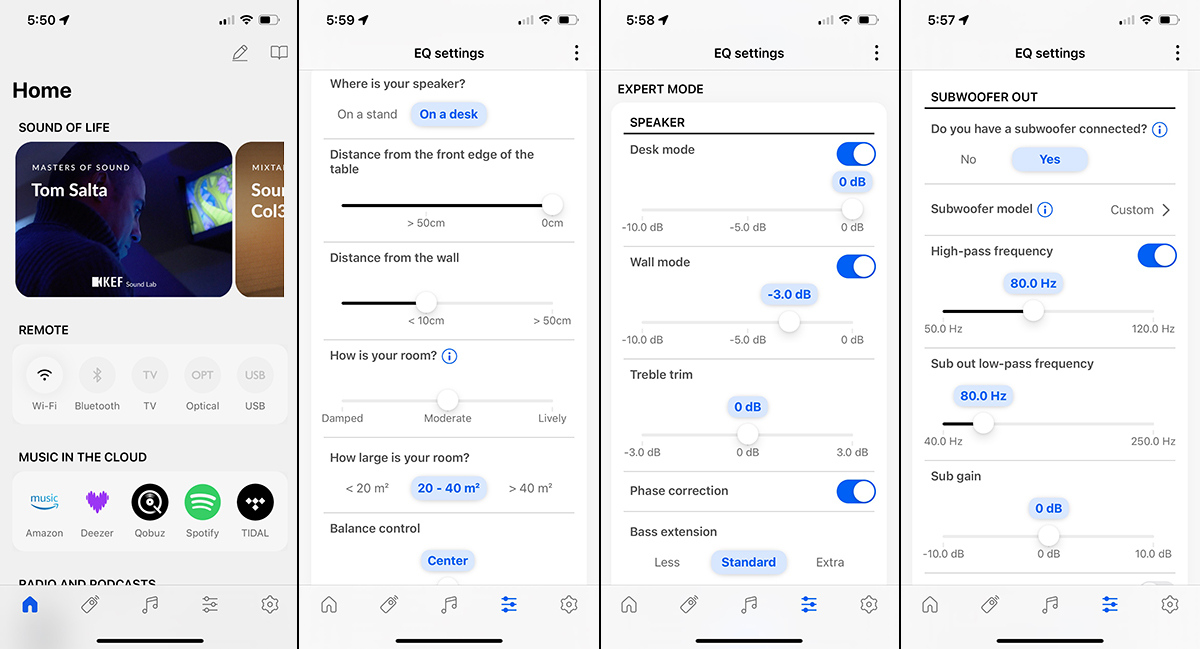
You can use the KEF Connect app to stream from supported services such as Amazon Music and Qobuz, listen to internet radio, and play podcasts. A function I found very useful was EQ Settings, which has two modes. In Normal mode, you can specify where the system is installed (on stands, on a desk), the distance from the front wall, and the size and acoustic character of your room, after which the app will create an appropriate EQ setting. You can also adjust left-right balance and configure a subwoofer if you’re using one. Expert mode allows finer adjustments, such as the amount of bass and treble cut you want to make to compensate for speaker placement and room acoustics.
Chromecast does not support gapless playback, but the LSX II LT was unusually slow loading tracks. Streaming from the Qobuz app to the LSX II LT via Chromecast, when one track finished playing, it took five to six seconds for the next track to load. This happened on both my iPhone and Pixel phone. But when I cast from the Qobuz app to the KEF LS60 Wireless system in my living room, it took less than a second for a new track to load. The LS60 and LSX II LT both employ KEF’s W2 streaming platform, so why the difference? Was there a defect in my review sample? If so, it did not manifest itself in any other way. Or was it inherent to the design—maybe less memory in the playback buffer? It was probably the former. I reported the problem to KEF, and they said they were unable to replicate it on an LSX II LT system in their offices. Go figure.
Other than the slow response with Chromecast, I did not experience any software or network problems with the LSX II LT.
Listening I
For my first round of listening, I placed the LSX II LT speakers on the shelf of the secretary desk in my home office. In this nearfield setup, the speakers were 3′ apart, tweeter to tweeter, and 3′ from my listening position as I leaned back in my office chair, with the tweeters almost exactly at ear level. I left the speakers pointed straight ahead, mainly because that’s the way they fit most easily on my shelf. There wasn’t much room to toe them in, and I didn’t feel the need to do so. Their rear panels were 4″ from the wall behind them. In that position, bass sounded a little thuddy with the default EQ setting, so I used the EQ Settings function in the KEF Connect app to create a new profile for the system, where I specified a speaker-to-wall distance of 10cm. That tightened up the bass nicely.
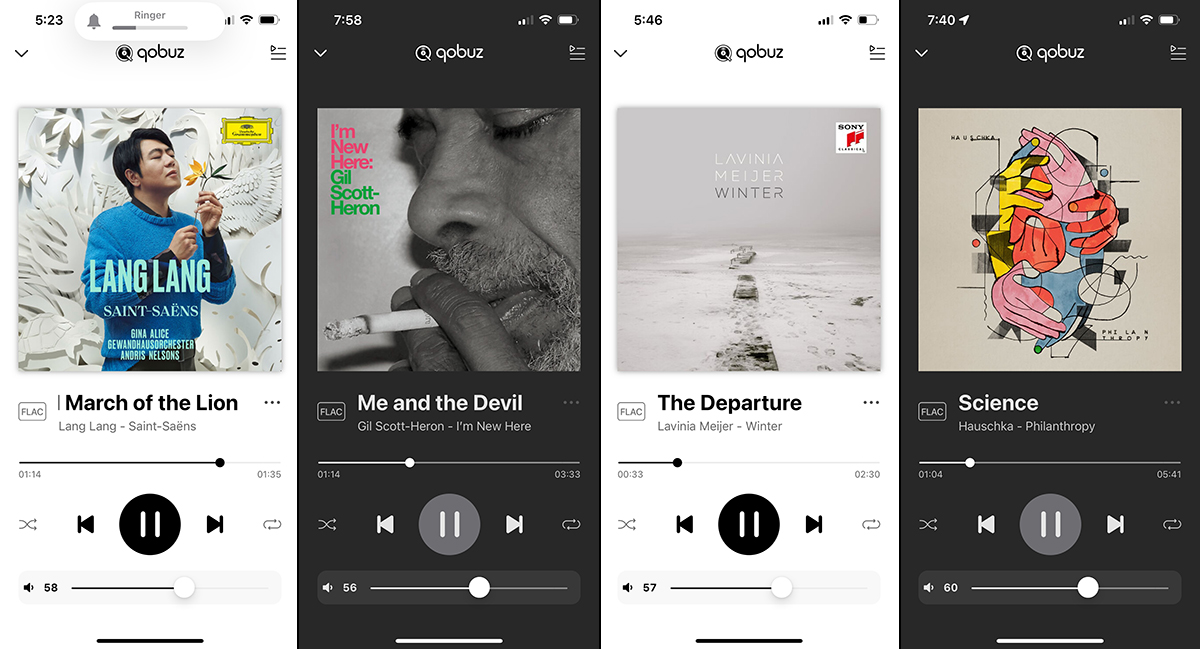
A new recording of The Carnival of the Animals by the French composer Camille Saint-Saëns with pianists Lang Lang and his wife Gina Alice Redlinger and the Leipzig Gewandhaus Orchestra conducted by Andris Nelsons (24-bit/192kHz FLAC, Deutsche Grammophon / Qobuz) demonstrated the KEF system’s many virtues, and also its limitations. Scored for two pianos and chamber ensemble, this 14-movement suite is a challenge for any music system, especially for one as compact as the LSX II LT.
On “Royal March of the Lion,” the opening fanfare played in the upper octaves by the two pianos sounded suitably majestic. The attacks of staccato notes and chords were thrillingly fast, but not overdone. When the strings enter a few bars later, I admired the transparent presentation. Violins had excellent texture, but sounded a tad steely. The tonality of the two pianos was consistent throughout their range. Later in the movement, Lang’s and Redlinger’s thunderous top-to-bottom runs were beautifully articulated. I heard no evidence of compression or congestion, but the loudest sections were a bit strident.
“The Cuckoo in the Depths of the Woods,” scored for two pianos and solo clarinet, was pure magic. The gentle low-pitched piano chords had surprising authority given the size of the speakers, and the higher-pitched chords had wonderful ringing clarity. The tone of the clarinet, playing the two-note imitation of the cuckoo, was perfect. Closing my eyes, it was easy to forget that I was listening in the nearfield.
Scored for two pianos, strings, clarinet, and xylophone, “Fossils” showed off the LSX II LT’s soundstaging and imaging chops, as well as its amazing dynamic capabilities. The pianos were clearly presented at the front of the soundstage, with strings right behind, the clarinet a little further back, and the xylophone further back still. As with “Royal March of the Lion,” the KEF system delivered astonishing dynamics—those dramatic xylophone notes just exploded out of these small speakers.
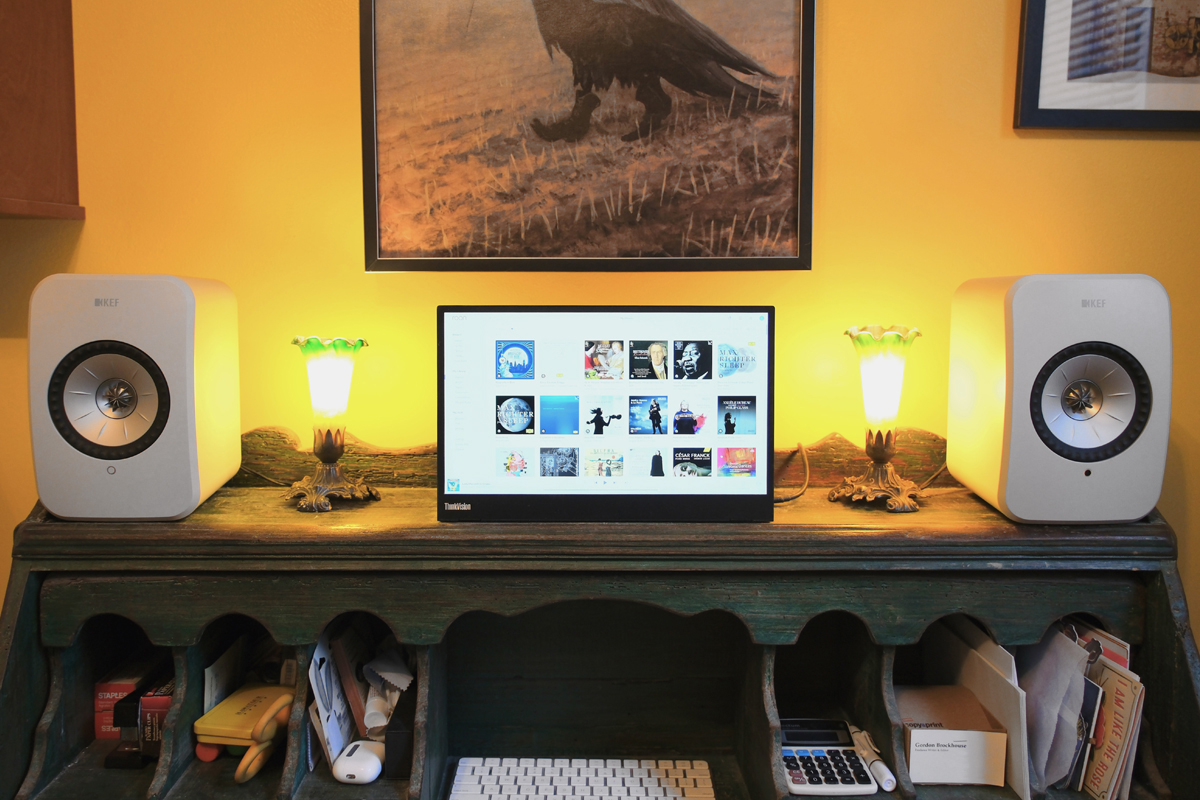
So did the nightmarish machine-gun-like electronic effects, sampled strings, and manic handclaps in Gil Scott-Heron’s cover of Robert Johnson’s “Me and the Devil” from his extraordinary 2010 album I’m New Here (16/44.1 FLAC, XL Recordings / Qobuz). This song is supposed to scare the bejeezus out of the listener, and amazingly, through the LSX II LT, it did. The KEF system convincingly rendered every snarl in Scott-Heron’s raw, bluesy baritone. Predictably, the huge hip-hop drum beats didn’t sound as deep and powerful as I’ve heard them, but they were impressively hard-hitting, considering the size of this system.
Time for something mellower—how about some harp music? If you think the harp is an easy instrument to reproduce, think again. The concert harp covers a very wide frequency range—from 30.9Hz to 2960Hz—with very rich harmonics. The sharp transients can easily excite speaker resonances.
I heard no such problems on Lavinia Meijer’s rendition of “The Departure” from Max Richter’s soundtrack for The Leftovers, the opening track on her album Winter (24/96 FLAC, Sony Classical / Qobuz). Through the LSX II LT, Meijer’s rapid-fire notes on the middle strings at the beginning had just the right amount of speed—they were fast and articulate. Her loud high notes when playing a simple two-note motif rang out beautifully without being overbearing. And the big notes played on the lower strings blew me away. They sounded delectable: rich and resonant, with crisp attacks followed by decays that went on and on, but weren’t at all exaggerated. It was meltingly beautiful.
Comparison I
In my home office, I compared the LSX II LT with a similar streaming active speaker system, PSB’s Alpha iQ ($1299). Each Alpha iQ enclosure houses a 4″ polypropylene midrange-woofer powered by a 60W class-D amp and a 0.75″ aluminum dome tweeter powered by a 30W class-D amp. I used pink noise to match levels of the two systems to within 0.5dB.
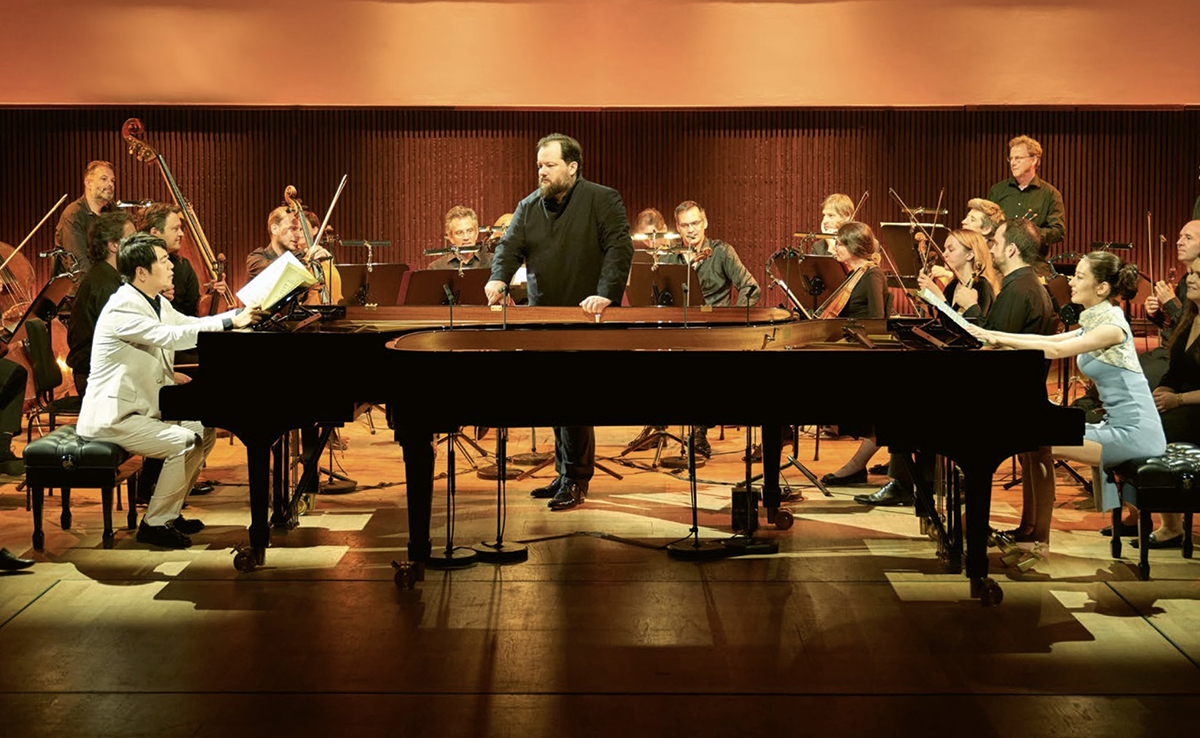
On The Carnival of the Animals, the KEF system delivered a more forward presentation—the PSB system was a little more recessed. Orchestral tone was fuller and richer through the PSB system, and smoother too. Violins had a bit more bite on the KEF system, but sounded steelier. The leading edges of Lang’s and Redlinger’s big staccato notes in “Royal March of the Lion” were more pronounced on the KEF system, but piano tone in these passages was a little more strident. With the EQ setting I had enabled in the KEF Connect app, the double basses did not sound as full and rich as they did through the Alpha iQ. Similarly, those big low-octave piano runs had a bit more authority through the PSB system. Disabling the EQ settings on the LSX II LT made those low notes as prominent as they were through the PSB system—not surprising given that I was not using any EQ with the PSB—but now the KEF system’s bass was not quite as clearly defined as it was on the PSB; there was a loss in articulation.
On “Cuckoo,” I heard more of the decay of the two pianos into the Leipzig concert hall on the KEF system than on the PSB. As on “Lion,” the piano was more recessed on the PSB system, more forward on the KEF. On “Fossils,” the KEF system sounded a little more congested, but it produced a deeper soundstage—the xylophone was further back.
Listening II
For my second round of listening, I moved the KEF system down to my basement family room, placed the speakers on the electric fireplace below my 50″ Samsung Frame TV, and connected the HDMI input on the primary speaker to the HDMI-ARC port on the Frame TV’s breakout box. The speakers were 42″ apart, their rear panels 8″ from the wall behind them. The drivers were slightly above ear level as I sat on a small sofa against the opposite wall, 6′ from the speakers. I adjusted the EQ settings in the KEF Connect app to reflect the different room conditions.

Wanting to hear how this compact system would fare with a big blockbuster movie, I opened the Apple TV+ app on my Frame TV and cued up Napoleon. The battle scenes were pretty impressive. As you’d expect from a system this small, the sounds of explosions, cannons, and musket fire did not have visceral impact—I heard them, but did not feel them. But they were nonetheless dramatic and powerful and heightened my involvement with the movie. More important, these sounds were well defined. Instead of indistinct booms, I heard clear leading edges followed by the echoes of the explosions through the battlefield. During these big moments, the speakers never sounded harsh or strained. Other effects—soldiers scaling the walls of a fortress, the clashing steel of hand-to-hand sword combat, shouted orders, neighing horses—were clearly rendered, convincingly conveying the chaos of the battlefield.
The system was just as satisfying in quieter scenes. Dialog was commendably natural and intelligible with both male and female voices. During interior scenes, voices echoed convincingly through palace rooms and audience chambers. And the musical soundtrack was lovely, with convincing timbres on all the instruments, from gentle fortepiano passages to bold brass passages.
What a contrast with the Frame TV’s built-in speakers, which sounded tinny and distorted. The cannons were more like peashooters!
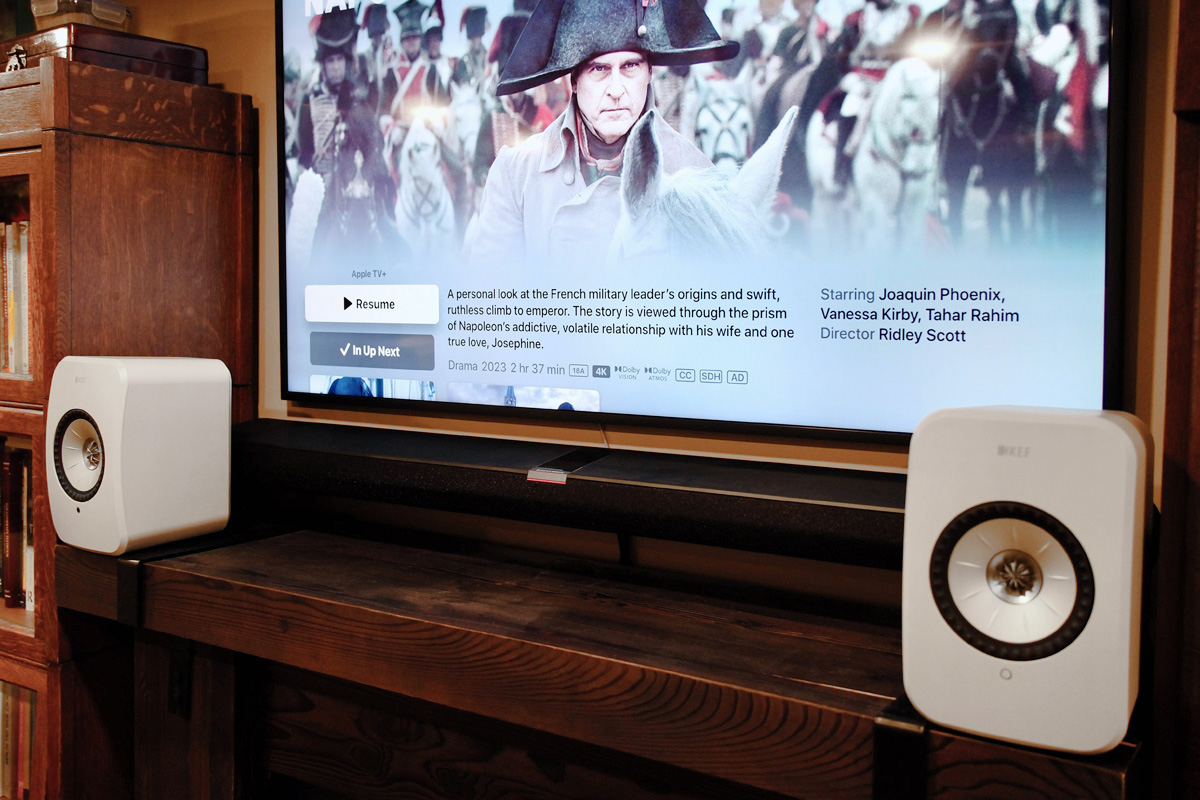
I also wanted to hear music in a non-nearfield setup, so cued up an album that has been in heavy rotation in my home since its October 2023 release—Philanthropy by the German keyboardist Volker Bertelmann, a.k.a. Hauschka (24/48 FLAC, City Slang / Qobuz). On the hard-driving “Inventions,” the percussive effects and electronic tones jumped out of the little enclosures into my family room, filling it effortlessly. The bass line was impressively deep and powerful. And I loved the way this system resolved all the elements in this dense, complex piece.
Comparison II
In my family room, I compared the LSX II LT with Bowers & Wilkins’s Panorama 3 Dolby Atmos soundbar ($999.99). The Panorama 3 is a 3.1.2 design, with a driver complement that reproduces three front channels, the low-frequency-effects (LFE) channel, and two height-effects channels.
The Frame TV was sending a two-channel downmix through the KEF system and a Dolby Atmos stream to the Panorama 3 soundbar. With the KEF speakers, audio was tied to the screen. The soundbar produced a much broader and higher soundstage, with the musical soundtrack appearing far to the sides of the soundbar and sound effects emerging from all over my room. As with the KEF system, cannons and explosions in the battle scenes from Napoleon were powerful but not visceral, but they sounded harsher and more strained through the soundbar. Dynamics were more compressed. Dialog was not as natural through the B&W bar—for example, Joaquin Phoenix’s voice had a slightly hollow character.
I also played “Inventions” by Hauschka through the B&W bar, but I streamed it from the Apple Music+ app on the Frame TV so that I could hear the Dolby Atmos mix. The mix was very effective, wrapping the whole room in music. Some electronic effects appeared several feet to the side of the bar, others a foot or two above the bar. But the sound was hollower and more dynamically compressed than the stereo mix was through the KEF system. Bass notes were not nearly as powerful. Percussive effects were less impactful and less clearly defined, but also harsher.
Conclusion
I mentioned one software issue in this review: slow response when streaming via Chromecast. But that was the only operational blip I experienced during my time with the LSX II LT. This is a solid little system.
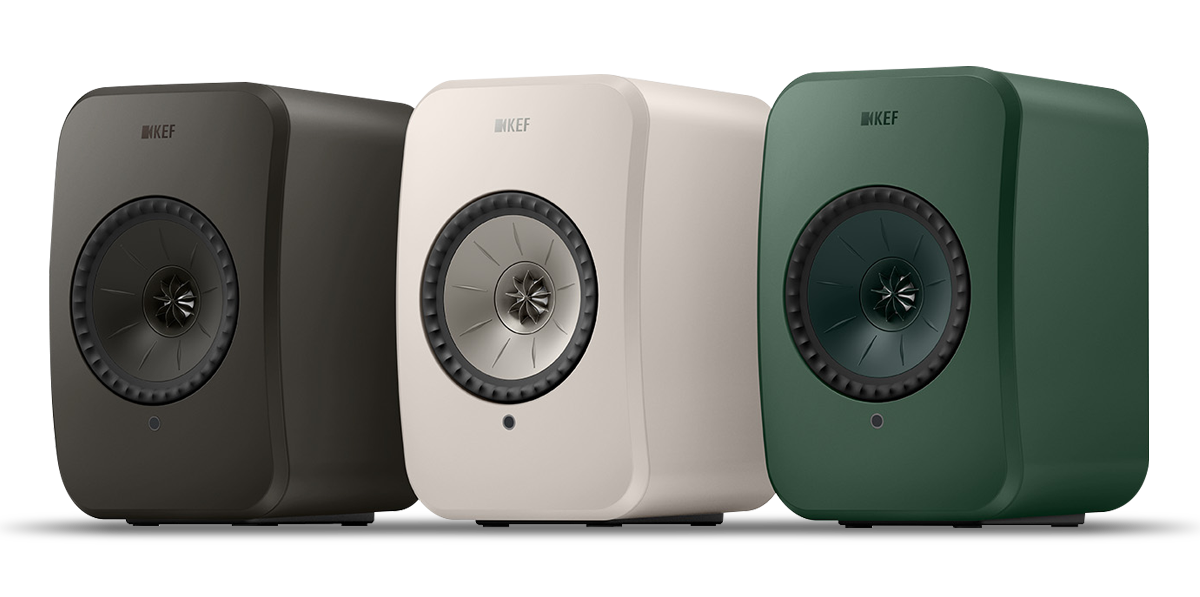
As to the sound, I have very few reservations. I occasionally heard some hardness on loud, demanding passages, but this happened rarely. Overall, I loved listening to the KEF LSX II LT system in both my home office and basement family room. Detail, soundstaging, and image specificity were all excellent. Given the size of the system’s enclosures and midrange-woofers, it delivered surprisingly dynamic sound.
If you’re looking for an affordable, compact, all-in-one active speaker system to use in a small- to medium-sized room, and you don’t require a wireless link between the primary and secondary speakers, this elegant little system belongs on your shortlist, at or near the top.
. . . Gordon Brockhouse
Associated Equipment
- Active speaker system: PSB Alpha iQ.
- Soundbar: Bowers & Wilkins Panorama 3.
- Display: Samsung QN50LS003 50″ UHD TV “The Frame.”
- Sources and control devices: Apple iPhone 14, Google Pixel 4a 5G, Apple Mac Mini (2020, M1), Apple MacBook Pro (2023, M3), HP Spectre x360 convertible notebook PC.
- Network: Google Wifi four-node mesh network.
KEF LSX II LT Streaming Active Loudspeaker System
Price: $999.99/system.
Warranty: Five years, parts and labor on drivers; two years on active electronics.
KEF
GP Acoustics (UK) Ltd.
Eccleston Road, Tovil
Maidstone, Kent ME15 6QP
United Kingdom
Phone: +44 (0)1622-672261
Fax: +44 (0)1622-750653
Email:
Website: www.kef.com
North America:
GP Acoustics (US) Ltd.
10 Timber Lane
Marlboro, NJ 07746
United States
Phone: (732) 683-2356
Fax: (732) 683-2358
Email:
Website: www.kef.com/us



